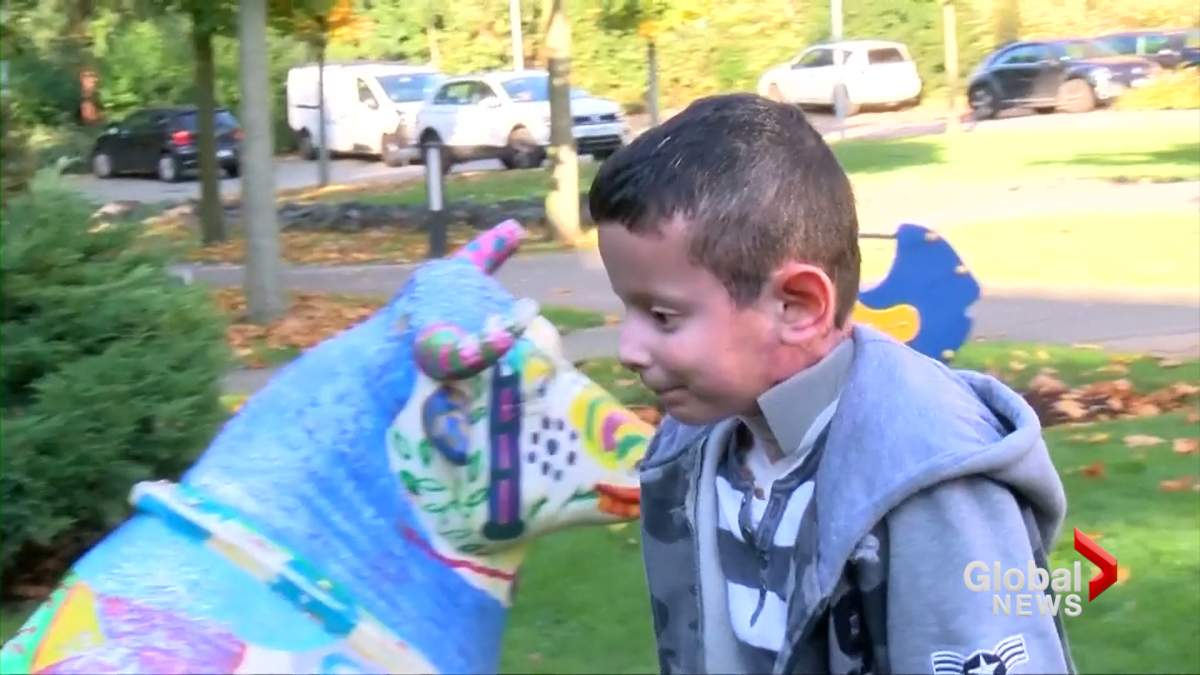For the first time, doctors have successfully grown genetically modified skin and used it to save a young boy’s life who was suffering from a debilitating genetic disorder.

Hassan, 9, was born with a disease known as junctional epidermolysis bullosa, a condition that makes the skin and organs fragile and prone to blistering.
READ MORE: ‘Butterfly boy’ living in Ontario with rare skin condition battling to find a cure
After years of trying to help Hassan, in 2015 his parents decided he would undergo an experimental treatment in Germany to save him.
“We decided to try it because we had no other choice. It was also hard to decide. We had to try everything for Hassan because he could not walk or eat well,” his father told Reuters.
WATCH: Treatment funding denied for 3 children with rare genetic disease
A research report, published in the biomedical journal Nature on Wednesday, said in 2015 German doctors used the highly experimental procedure to successfully replace 80 per cent of Hassan’s skin, using genetically modified stem cells.
The procedure is the first of its kind and doctors, excited about its success, are now eager to take their research into clinical trials.
Hassan’s last name, as well as the first names of his family members, are not being disclosed to protect the privacy of the family.
‘Butterfly children’
When Hassan was born, he developed blisters all over his body, mostly on his limbs and back. When he was six weeks old, his condition deteriorated and he had a complete loss of about 60 per cent of the skin on his body.
People with the condition are sometimes called “butterfly children” because their skin is as fragile as the insect’s wings. Even mild friction or bumps can cause severe blistering. Children with the disease often have difficulty with daily activities, such as walking, eating and even breathing.

Get weekly health news
WATCH: Baby with rare skin disease makes her untouchable
It affects between 3,000 and 5,000 Canadians.
This includes Jonathan Pitre, an Ontario teenager who was born with the disease. Like Hassan, he spent most of his life with painful, burn-like blisters all over his body.
In 2016, Pitre also underwent an experimental treatment in Minnesota where he received a stem-cell transplant with donor tissue from his mother and underwent chemotherapy that decimated his immune system and allowed the donated cells to take hold.
This experiment also seemed to have been successful and Pitre’s body is now producing its own healthy blood cells.
WATCH: Young Ontario boy hopes to make difference for others with same disease
Hassan’s skin surgery — a first of its kind
When Hassan arrived at the German hospital in 2015, he was seriously ill and unable to walk and eat.
In a desperate effort to save his life, doctors decided to explore the experimental procedure. They took a small biopsy, which was around four square centimetres, from an unaffected part of Hassan’s skin.
They grew a genetically corrected version of his skin cells in a lab. The skin cells then grew into sheets that the surgeons grafted onto Hassan’s body.
The first procedure took place in October 2015 and doctor’s applied the skin to Hassan’s legs and arms. A month later they grafted the skin to his back and other affected areas.
His skin started to regenerate and after time, 80 per cent of his epidermis was restored through the surgeries.
‘Back in school, active in sports’
- This H3N2 flu strain is spreading ‘rapidly.’ Why subclade K is hitting hard
- U.S. may soon reclassify marijuana to allow medical research. What to know
- EU proposal would ease cross-border abortion access for women facing bans
- Ontario influenza ICU admissions up 127% in past week, hospital association warns
More than two years after the procedure, doctors said Hassan’s skin has healed normally — it does not form any more blisters and doesn’t require medications or ointment.
“The skin has been stable for two years, that is a relatively long period. He (Hassan) has recovered so well, he’s back in school, again active in sports,” one of Hussan’s doctors told Reuters.
Hassan’s father said the boy now feels like a normal person. He is active and likes his life.
“I hope all children (with diseases like Hassan) can have this treatment,” his father said.
Doctors are now hoping to bring the research to clinical trials in order to possibly treat other children living with this disease.
WATCH: Great Dane helps 11-year-old with genetic disorder walk
— With files from Reuters








Comments